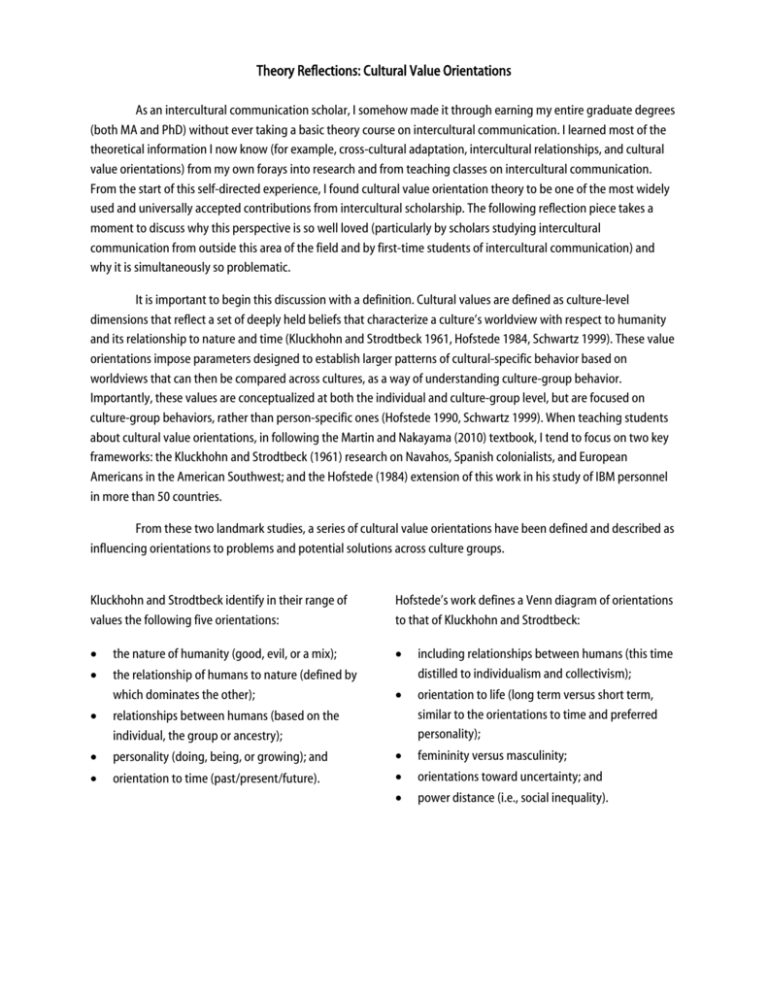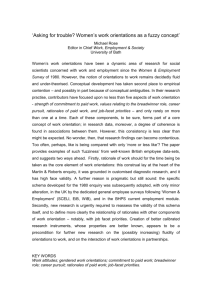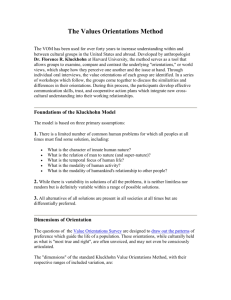Theory Reflections: Cultural Value Orientations
advertisement

Theory Reflections: Cultural Value Orientations As an intercultural communication scholar, I somehow made it through earning my entire graduate degrees (both MA and PhD) without ever taking a basic theory course on intercultural communication. I learned most of the theoretical information I now know (for example, cross-cultural adaptation, intercultural relationships, and cultural value orientations) from my own forays into research and from teaching classes on intercultural communication. From the start of this self-directed experience, I found cultural value orientation theory to be one of the most widely used and universally accepted contributions from intercultural scholarship. The following reflection piece takes a moment to discuss why this perspective is so well loved (particularly by scholars studying intercultural communication from outside this area of the field and by first-time students of intercultural communication) and why it is simultaneously so problematic. It is important to begin this discussion with a definition. Cultural values are defined as culture-level dimensions that reflect a set of deeply held beliefs that characterize a culture’s worldview with respect to humanity and its relationship to nature and time (Kluckhohn and Strodtbeck 1961, Hofstede 1984, Schwartz 1999). These value orientations impose parameters designed to establish larger patterns of cultural-specific behavior based on worldviews that can then be compared across cultures, as a way of understanding culture-group behavior. Importantly, these values are conceptualized at both the individual and culture-group level, but are focused on culture-group behaviors, rather than person-specific ones (Hofstede 1990, Schwartz 1999). When teaching students about cultural value orientations, in following the Martin and Nakayama (2010) textbook, I tend to focus on two key frameworks: the Kluckhohn and Strodtbeck (1961) research on Navahos, Spanish colonialists, and European Americans in the American Southwest; and the Hofstede (1984) extension of this work in his study of IBM personnel in more than 50 countries. From these two landmark studies, a series of cultural value orientations have been defined and described as influencing orientations to problems and potential solutions across culture groups. Kluckhohn and Strodtbeck identify in their range of values the following five orientations: Hofstede’s work defines a Venn diagram of orientations to that of Kluckhohn and Strodtbeck: the nature of humanity (good, evil, or a mix); the relationship of humans to nature (defined by which dominates the other); including relationships between humans (this time distilled to individualism and collectivism); orientation to life (long term versus short term, similar to the orientations to time and preferred personality); relationships between humans (based on the individual, the group or ancestry); personality (doing, being, or growing); and femininity versus masculinity; orientation to time (past/present/future). orientations toward uncertainty; and power distance (i.e., social inequality). I should mention here that my inherently interpretive approach to intercultural communication scholarship finds much of this research problematic from the start. The notion that a series of cultural values developed to describe the worldviews of Native Americans, Spanish Colonials, and European Americans has been adopted, adapted, and extended to create a comparative understanding of all of humankind is one that I am constantly confounded by. Aren’t such frameworks inherently essentializing—leading naïve scholars and sojourners to oversimplify and overgeneralize, possibly even stereotype culturally ‘different ‘others? Further, how does such a perspective take on cultural value heterogeneity—that not all individual members of cultures share the same worldview frameworks?1 Such critiques become more salient when situating the movement within intercultural studies toward multiculturalism and diversity research, “Culture is becoming increasingly deterritorialized and penetrated by elements from other cultures. This is resulting in…cultural pluralism and hybridization. It has become more difficult to study culture as it is becoming diffuse,” as described by Craig and Douglas (2006, 322). Cultural value orientations have been criticized in light of multiculturalism, cultural boundary blurriness and hybridization as essentializing, limited, unrealistic, over-applied, and universalist (see Kagiçibasi 1997)—particularly when applied as an either/or phenomenon to operationalizing culture (i.e., one cannot be simultaneously individualist and collectivist). And yet, the value dimensions of individualism versus collectivism have been used in intercultural research across disciplines, spanning from the 1960s through the present.2 For example, in a search of “individualism AND collectivism” in the International Journal of Intercultural Relations, I found 205 articles using those terms in their titles alone. Cultural value orientations are used as dimensions through which to describe, understand, and critique cultural patterns in fields as wide-ranging as consumer research, international business, cross-cultural psychology, child development, international relations, anthropology, social history, and cross-cultural training. Indeed, these values have been expanded to include any and every marker of cultural belief, including modernity versus traditionalism (Chandler 1979); familialism, romanticism, and spiritualism (Gaines, Jr. et al. 2005); independent vs. interdependent self-construals (Markus and Kitiyama 1991); hedonism, benevolence, conformity, and self-direction (Schwartz 1999). Further, I have found in speaking with students and colleagues over the years (as well as grading and reviewing countless papers and articles at the professional, graduate, and undergraduate levels) that these value dimensions are the aspect of the class that they can most fruitfully apply and most easily recall (the other most probably involving cross-cultural comparisons of nonverbal behaviors). Thus, on both scholarly and pragmatic levels, cultural value orientation theories are both intuitively appealing and, it seems, highly useful. So how can I reconcile my conundrum—that such frameworks can be simultaneously problematic and constructive? Taking the perspective that value orientations do not have to contain mutually exclusive categories (that they can be both/and rather than either/or) is one way of approaching this challenge. Perceiving values more as dialectical tensions, as seen in work by Martin and Nakayama (1999), allows these dimensions to coexist within all individuals at levels that vary situationally, individually, and contextually. 1 See Martin and Nakayama’s (1999) discussion of the cultural-individual dialectic for further discussion of this point. 2 The other value orientations are also highly utilized in intercultural research, most notably orientations to time and life, power distance, and uncertainty avoidance. However, the individualism and collectivism have received by far the most press, and are therefore my focal point here. Indeed, replications of comparative studies on Anglo-American and Mexican-American values similar to Kluckhohn and Strodtbeck’s (1961) work have found that values of modernity versus traditionalism are converging and even switching over time, with Anglo-Americans moving toward traditionalist orientations while MexicanAmericans are moving toward modernity (Chandler, Tsai, and Wharton 1999). In order to accept the usefulness of cultural values as descriptors and comparison points across cultures, it is imperative to understand that such values are constantly shifting and changing, depending on the context of the situation—that people are dynamic, and are continuously reassessing their worldviews through the lenses of their experiences (Smith and Schwartz 1997). Cultural values are indeed valuable when it comes to understanding and subverting social norms, in that they are subjective, relative, and evaluative. They are intuitively appealing because they help us to understand and compare who we are to people with differing cultural backgrounds to ours. However, conflating cultural value orientations with nation-state borders and attempting to force essentializing behavioral characteristics on individuals simply due to culture-group memberships is the least useful way through which to conceptualize such theoretical perspectives. In the end, cultural value orientations must be taken into context as a social-scientific approach to intercultural communication research—these are theories that explain and even predict behavior, but behaviors cannot be required to conform to such frameworks. As such, it is logical that it is not possible to become a scholar of intercultural communication without understanding how these values can be applied before critiquing their usefulness within the field. Thus, it can easily be seen how my self-guided tour through intercultural communication was so deeply imbedded in theories of cultural values, and how those theories are so well-adapted across disciplines and cultures. – Miriam Shoshana Sobré-Denton Bibliography Chandler, Charles, Yung-mei Tsai, and Renee Wharton. 1999. “Twenty Years After: Replicating a Study of Anglo and Mexican American Cultural Values.” The Social Science Journal 36, 2:353-367. Chandler, Charles R. 1979. “Traditionalism in a Modern Setting: A Comparison of Anglo- and Mexican-American Value Orientations.” Human Organization 38, 7:153-159. Craig, C. Samuel, and Susan P. Douglas. 2006. “Beyond National Culture: Implications of Cultural Dynamics for Consumer Research.” International Marketing Review 23, 3:322-342. Gaines Jr., Stanley O., Michael C. Henderson, Mary Kim, Samuel Gilstrap, Jennifer Yi, Caryl E. Rusbult, Deletha P. Hardin, and Lowell Gaertner. 2005. “Cultural Value Orientations, Internalized Homophobia, and Accommodation in Romantic Relationships.” Journal of Homosexuality 50, 1:97-117. Hofstede, Geert. 1984. Culture’s Consequences. Beverly Hills, CA: Sage. Hofstede, Geert. 1990. Cultures and Organizations: Software of the Mind. London: McGraw-Hill. Kagiçibasi, C. 1997. “Individualism and Collectivism.” In The Handbook of Cross-Cultural Psychology, Vol. 2, eds. John W. Berry, Marshall H. Segall, and Cigdem Kagiçibasi. pp. 1-51. Boston: Allen and Bacon. Kluckhohn, Florence, and Fred Strodtbeck. 1961. Variations in Value Orientations. Chicago: Row, Peterson. Markus, Hazel, and Shinobu Kitiyama. 1991. “Culture and the Self: Implications for Cognition, Emotion, and Motivation.” Psychological Review 98:224-253. Martin, Judith N., and Thomas K. Nakayama. 1999. “Thinking Dialectically about Culture and Communication.” Communication Theory 9:1-25. Martin, Judith N., and Thomas K. Nakayama. 2010. Intercultural Communication in Contexts, 5th edition. Boston: McGraw Hill. Schwartz, Shalom H. 1999. “Theory of Cultural Values and Some Implications for Work.” Applied Psychology: An International Review 48, 1:23-47. Smith, Peter B. and Shalom H. Schwartz. 1997. “Values.” In The Handbook of Cross-Cultural Psychology, Vol. 2, eds. John W. Berry, Marshall H. Segall, and Cigdem Kagiçibasi. pp. 77-118. Boston: Allen and Bacon.





